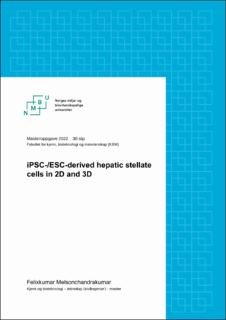| dc.contributor.advisor | Aizenstadt, Aleksandra | |
| dc.contributor.advisor | Diep, Dzung Bao | |
| dc.contributor.advisor | Krauss, Stefan | |
| dc.contributor.advisor | Wilhelmsen, Ingrid | |
| dc.contributor.author | Melsonchandrakumar, Felixkumar | |
| dc.date.accessioned | 2022-12-12T12:13:34Z | |
| dc.date.available | 2022-12-12T12:13:34Z | |
| dc.date.issued | 2022 | |
| dc.identifier.uri | https://hdl.handle.net/11250/3037244 | |
| dc.description.abstract | Liver Fibrosis is a major concern for the world as it causes chronic inflammation which again induces an unhealthy and abnormal healing response. Most common causes to liver fibrosis are alcohol consumption, non-alcoholic steatohepatitis (NASH), hepatitis B(HBV), autoimmune hepatitis, non-alcoholic fatty liver disease (NAFLD) and cholestatic liver diseases. Continuous fibrosis in the liver can lead to losing normal function of the liver and eventually end with liver failure. As of now in vitro models of hepatic stellate cells (HSCs) are needed to eventually be able to produce models that can be used to test treatments against fibrosis.
By differentiating HSCs from iPSCs and hESC the derived cells were tested with both immunostaining and RT-qPCR which checked gene expression to conclude if the cells had differentiated into HSC-like cells.
The iHSCs were then used to construct two types of 3D cultures where the one culture called HSC in GelTrex. GelTrex matrix were selected to mimic ECM of space of Disse, which is a mixture of reduced growth factor (RGF) and basement membrane extract (BME). The GelTrex samples were also treated with TGF-β1 to see if this would increase expression of fibrosis-associated genes and to investigate presence of fibrosis-associated proteins. The GelTrex samples showed none reproduceable results as the construction of the GelTrex droplet was unsuccessful, due to air bubbles effecting the 3D culture. The RNA isolation was performed with poor technique at the RNA extraction step, which resulted in a deviation throughout the results.
The other 3D culture was called for spheroid models, which were made with co-culturing of HepG2 and iHSC to mimic the cell-cell interaction. Construction of the spheroids were done by a mixture of HepG2 and HSC with a 5:1 ratio. The cells were separated into control and cells treated with TGF-β1. The cells were sorted from the spheroid and analyzed for changed in gene expression. Sorting showed proliferation of HepG2 in spheroids, which elevated the ratio, and there for the ratio should be tweaked to lower for construction on spheroids. RT-qPCR showed error in RNA extraction in RNA isolation together with the time span on sorting cells, which might have been too low. | en_US |
| dc.language.iso | eng | en_US |
| dc.publisher | Norwegian University of Life Sciences, Ås | en_US |
| dc.rights | Attribution-NonCommercial-NoDerivatives 4.0 Internasjonal | * |
| dc.rights.uri | http://creativecommons.org/licenses/by-nc-nd/4.0/deed.no | * |
| dc.title | iPSC-/ESC-derived hepatic stellate cells in 2D and 3D | en_US |
| dc.type | Master thesis | en_US |
| dc.description.localcode | M-KB | en_US |

